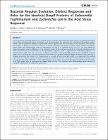| dc.contributor.author | DORMAN, CHARLES | en |
| dc.date.accessioned | 2014-10-01T11:54:32Z | |
| dc.date.available | 2014-10-01T11:54:32Z | |
| dc.date.issued | 2014 | en |
| dc.date.submitted | 2014 | en |
| dc.identifier.citation | Quinn HJ, Cameron ADS, Dorman CJ, Bacterial regulon evolution: distinct responses and roles for the identical OmpR proteins of Salmonella Typhimurium and Escherichia coli in the acid stress response, PLoS Genetics, 10, 3, 2014, e1004215 | en |
| dc.identifier.other | Y | en |
| dc.identifier.uri | http://hdl.handle.net/2262/71416 | |
| dc.description | PUBLISHED | en |
| dc.description.abstract | The evolution of new gene networks is a primary source of genetic innovation that allows bacteria to explore and exploit new niches, including pathogenic interactions with host organisms. For example, the archetypal DNA binding protein, OmpR, is identical between Salmonella Typhimurium serovar Typhimurium and Escherichia coli, but regulatory specialization has resulted in different environmental triggers of OmpR expression and largely divergent OmpR regulons. Specifically, ompR mRNA and OmpR protein levels are elevated by acid pH in S. Typhimurium but not in E. coli. This differential expression pattern is due to differences in the promoter regions of the ompR genes and the E. coli ompR orthologue can be made acid-inducible by introduction of the appropriate sequences from S. Typhimurium. The OmpR regulon in S. Typhimurium overlaps that of E. coli at only 15 genes and includes many horizontally acquired genes (including virulence genes) that E. coli does not have. We found that OmpR binds to its genomic targets in higher abundance when the DNA is relaxed, something that occurs in S. Typhimurium as a result of acid stress and which is a requirement for optimal expression of its virulence genes. The genomic targets of OmpR do not share a strong nucleotide sequence consensus: we propose that the ability of OmpR to recruit additional genes to its regulon arises from its modest requirements for specificity in its DNA targets with its preference for relaxed DNA allowing it to cooperate with DNA-topology-based allostery to modulate transcription in response to acid stress. | en |
| dc.format.extent | e1004215 | en |
| dc.language.iso | en | en |
| dc.relation.ispartofseries | PLoS Genetics | en |
| dc.relation.ispartofseries | 10 | en |
| dc.relation.ispartofseries | 3 | en |
| dc.rights | Y | en |
| dc.subject | DNA transcription | en |
| dc.subject | DNA-binding proteins | en |
| dc.title | Bacterial regulon evolution: distinct responses and roles for the identical OmpR proteins of Salmonella Typhimurium and Escherichia coli in the acid stress response | en |
| dc.type | Journal Article | en |
| dc.contributor.sponsor | Science Foundation Ireland (SFI) | en |
| dc.type.supercollection | scholarly_publications | en |
| dc.type.supercollection | refereed_publications | en |
| dc.identifier.peoplefinderurl | http://people.tcd.ie/cjdorman | en |
| dc.identifier.rssinternalid | 90819 | en |
| dc.identifier.doi | http://dx.doi.org/10.1371/journal.pgen.1004215 | en |
| dc.rights.ecaccessrights | openAccess | |
| dc.subject.TCDTheme | Genes & Society | en |
| dc.subject.TCDTheme | Immunology, Inflammation & Infection | en |




